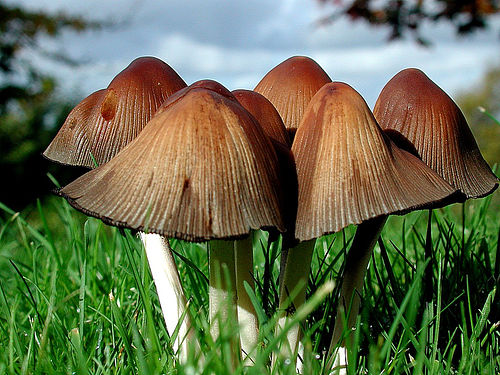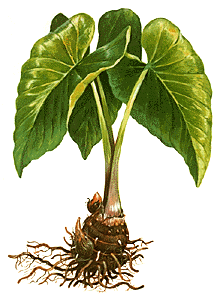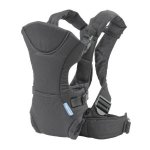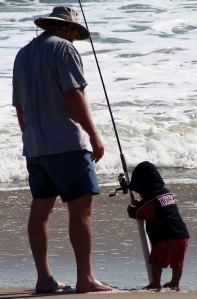Survival Tip of the Day brought to you by Kershaw.
Edibility of Plants
Plants are valuable sources of food because they are widely available, easily procured and, in the proper combinations, can meet all your nutritional needs.
WARNING: The critical factor in using plants for food is to avoid accidental poisoning. Eat only those plants you can positively identify and you know are safe to eat.
Absolutely identify plants before using them as food. Poison hemlock has killed people who mistook it for its relatives, wild carrots and wild parsnips.
At times you may find yourself in a situation for which you could not plan. In this instance you may not have had the chance to learn the plant life of the region in which you must survive. In this case you can use the Universal Edibility Test to determine which plants you can eat and which to avoid.
It is important to be able to recognize both cultivated and wild edible plants in a survival situation. Most of the information in this is directed toward identifying wild plants because information relating to cultivated plants is more readily available. Remember the following when collecting wild plants for food:
• Plants growing near homes and occupied buildings or along roadsides may have been sprayed with pesticides. Wash them thoroughly. In more highly developed countries with many automobiles, avoid roadside plants, if possible, due to contamination from exhaust emissions.
• Plants growing in contaminated water or in water containing Giardia lamblia and other parasites are contaminated themselves. Boil or disinfect them.
• Some plants develop extremely dangerous fungal toxins. To lessen the chance of accidental poisoning, do not eat any fruit that is starting to spoil or showing signs of mildew or fungus.
• Plants of the same species may differ in their toxic or sub toxic compounds content because of genetic or environmental factors. One example of this is the foliage of the common chokecherry. Some chokecherry plants have high concentrations of deadly cyanide compounds while others have low concentrations or none. Horses have died from eating wilted wild cherry leaves. Avoid any weed, leaves or seeds with an almond-like scent, a characteristic of the cyanide compounds.
• Some people are more susceptible to gastric distress (from plants) than others. If you are sensitive in this way, avoid unknown wild plants. If you are extremely sensitive to poison ivy, avoid products from this family, including any parts from sumacs, mangoes and cashews.
• Some edible wild plants, such as acorns and water lily rhizomes, are bitter. These bitter substances, usually tannin compounds, make them unpalatable. Boiling them in several changes of water will usually remove these bitter properties.
• Many valuable wild plants have high concentrations of oxalate compounds, also known as oxalic acid. Oxalates produce a sharp burning sensation in your mouth and throat and damage the kidneys. Baking, roasting or drying usually destroys these oxalate crystals. The corm (bulb) of the jack-in-the-pulpit is known as the “Indian turnip,” but you can eat it only after removing these crystals by slow baking or by drying.
WARNING: Do not eat mushrooms in a survival situation! The only way to tell if a mushroom is edible is by positive identification. There is no room for experimentation. Symptoms of the most dangerous mushrooms affecting the central nervous system may show up after several days have passed when it is too late to reverse their effects.

stay away from mushrooms in the wild
How to Test Plants for Edibility
There are many plants throughout the world. Tasting or swallowing even a small portion of some can cause severe discomfort, extreme internal disorders and even death. Therefore, if you have the slightest doubt about a plant’s edibility, apply the Universal Edibility Test before eating any portion of it.
Before testing a plant for edibility, make sure there are enough plants to make the testing worth your time and effort. Each part of a plant (roots, leaves, flowers and so on) requires more than 24 hours to test. Do not waste time testing a plant that is not relatively abundant in the area.
Remember, eating large portions of plant food on an empty stomach may cause diarrhea, nausea or cramps. Two good examples of this are such familiar foods as green apples and wild onions. Even after testing plant food and finding it safe, eat it in moderation. You can see from the steps and time involved in testing for edibility just how important it is to be able to identify edible plants.
To avoid potentially poisonous plants, stay away from any wild or unknown plants that have —
• Milky or discolored sap.
• Beans, bulbs or seeds inside pods.
• Bitter or soapy taste.
• Spines, fine hairs or thorns.
• Dill, carrot, parsnip or parsley-like foliage.
• “Almond” scent in woody parts and leaves.
• Grain heads with pink, purplish or black spurs.
• Three-leafed growth pattern.
Using the above criteria as eliminators when choosing plants for the Universal Edibility Test will cause you to avoid some edible plants. More important, these criteria will often help you avoid plants that are potentially toxic to eat or touch.
The Universal Edibility Test:
1 – Test only one part of a potential food plant at a time.
2 – Separate the plant into its basic components — leaves, stems, roots, buds and flowers.
3 – Smell the food for strong or acid odors. Remember, smell alone does not indicate a plant is edible or inedible.
4 – Do not eat for eight hours before starting the test.
5 – During the eight hours you abstain from eating, test for contact poisoning by placing a piece of the plant part you are testing on the inside of your elbow or wrist. Usually 15 minutes is enough time to allow for a reaction.
6 – During the test period, take nothing by mouth except purified water and the plant part you are testing.
7 – Select a small portion of a single part and prepare it the way you plan to eat it.
8 – Before placing the prepared plant part in your mouth, touch a small portion (a pinch) to the outer surface of your lip to test for burning or itching.
9 – If after three minutes there is no reaction on your lip, place the plant part on your tongue, holding it there for 15 minutes.
10 – If there is no reaction, thoroughly chew a pinch and hold it in your mouth for 15 minutes. Do not swallow.
11 – If no burning, itching, numbing, stinging or other irritation occurs during the 15 minutes, swallow the food.
12 – Wait eight hours. If any ill effects occur during this period, induce vomiting and drink a lot of water.
13 – If no ill effects occur, eat 0.25 cup of the same plant part prepared the same way. Wait another eight hours. If no ill effects occur, the plant part as prepared is safe for eating.
CAUTION: Test all parts of the plant for edibility, as some plants have both edible and inedible parts. Do not assume that a part that proved edible when cooked is also edible when raw. Test the part raw to ensure edibility before eating raw. The same part or plant may produce varying reactions in different individuals.
A List of Plants You Can Eat
An entire encyclopedia of edible wild plants could be written, but space limits the number of plants presented here. Learn as much as possible about the plant life of the areas where you train regularly and where you expect to be traveling or working.
EDIBLE AND MEDICINAL PLANTS:
TEMPERATE ZONE FOOD PLANTS

dandelion leaves
• Amaranth (Amaranthus retroflexus and other species)
• Arrowroot (Sagittaria species)
• Asparagus (Asparagus officinalis)
• Beechnut (Fagus species)
• Blackberries (Rubus species)
• Blueberries (Vaccinium species)
• Burdock (Arctium lappa)
• Cattail (Typha species)
• Chestnut (Castanea species)
• Chicory (Cichorium intybus)
• Chufa (Cyperus esculentus)
• Dandelion (Taraxacum officinale)
• Daylily (Hemerocallis fulva)
• Nettle (Urtica species)
• Oaks (Quercus species)
• Persimmon (Diospyros virginiana)
• Plantain (Plantago species)
• Pokeweed (Phytolacca americana)
• Prickly pear cactus (Opuntia species)
• Purslane (Portulaca oleracea)
• Sassafras (Sassafras albi um)
• Sheep sorrel (Rumex acetosella)
• Strawberries (Fragaria species)
• Thistle (Cirsium species)
• Water lily and lotus (Nuphar, Nelumbo and other species)
• Wild onion and garlic (Allium species)
• Wild rose (Rosa species)
• Wood sorrel (Oxalis species)
TROPICAL ZONE FOOD PLANTS

taro plant
• Bamboo (Bambusa and other species)
• Bananas (Musa species)
• Breadfruit (Artocarpus incisa)
• Cashew nut (Anacarium occidental)
• Coconut (Cocos nucifera)
• Mango (Mangifera indica)
• Palms (various species)
• Papaya (Carica species)
• Sugarcane (Saccharum officinarum)
• Taro (Colocasia species)
DESERT ZONE FOOD PLANTS
• Acacia (Acacia farnesiana)
• Agave (Agave species)
• Cactus (various species)
• Date palm (Phoenix actylifera)
• Desert amaranth (Amaranths palmeri)
SEAWEEDS

kelp
One plant you should never overlook is seaweed. It is a form of marine algae found on or near ocean shores. There are also some edible freshwater varieties. Seaweed is a valuable source of iodine, other minerals and vitamin C. Large quantities of seaweed in an unaccustomed stomach can produce a severe laxative effect.
When gathering seaweeds for food, find living plants attached to rocks or floating free. Seaweed washed onshore any length of time may be spoiled or decayed. You can dry freshly harvested seaweeds for later use.
Its preparation for eating depends on the type of seaweed. You can dry thin and tender varieties in the sun or over a fire until crisp. Crush and add these to soups or broths. Boil thick, leathery seaweeds for a short time to soften them. Eat them as a vegetable or with other foods. You can eat some varieties raw after testing for edibility.
• Dulse (Rhodymenia palmata)
• Green seaweed (Ulva lactuca)
• Irish moss (Chondrus crispus)
• Kelp (Alaria esculenta)
• Laver (Porphyra species)
• Mojaban (Sargassum fulvellum)
• Sugar wrack (Laminaria saccharina)
Information courtesy of the U.S. Army Survival Manual.
Thanks again to Kershaw. You can like Kershaw and Zero Tolerance Knives on Facebook.
– Tim
 Integrate babies into your workout routine. I regularly add my baby into my workout by using him as additional weight when doing situps or lifting him with different exercises. Not only is this good exercise for me, but it is also good bonding time between us as we can play and work out at the same time. A baby carrier is also good as you can wear it while doing pushups, everyday manual tasks, or even while going on walks. Your training while carrying a baby may come in handy later when you actually have to carry that baby for long stretches of time.
Integrate babies into your workout routine. I regularly add my baby into my workout by using him as additional weight when doing situps or lifting him with different exercises. Not only is this good exercise for me, but it is also good bonding time between us as we can play and work out at the same time. A baby carrier is also good as you can wear it while doing pushups, everyday manual tasks, or even while going on walks. Your training while carrying a baby may come in handy later when you actually have to carry that baby for long stretches of time. Teach your kids the basics as soon as possible. Soon your child will be walking and able to do simple tasks. Don’t count out a child’s ability to reason and help out. You might begin to teach them gun safety, but before they are ready for that you can involve them in even more important basic skills, such as finding food, starting a fire, or building shelters. Teach these basics to your kids and they will be able to do their part and they will also be equipped for future survival. Show your kids how to bait a hook, forage for edible plants, find good sources of water, or construct a basic shelter. Help them learn the essentials in an emergency supply kit. Several websites have information and games they can play to help them (and you) learn these things, such as FEMA or Equipped To Survive. Putting this information in the form of simple songs or rhythms will help them learn it. Even if there are tasks they are physically unable to perform a child’s memory is very good when properly engaged, and they will be able to retain this useful information even when you might forget something.
Teach your kids the basics as soon as possible. Soon your child will be walking and able to do simple tasks. Don’t count out a child’s ability to reason and help out. You might begin to teach them gun safety, but before they are ready for that you can involve them in even more important basic skills, such as finding food, starting a fire, or building shelters. Teach these basics to your kids and they will be able to do their part and they will also be equipped for future survival. Show your kids how to bait a hook, forage for edible plants, find good sources of water, or construct a basic shelter. Help them learn the essentials in an emergency supply kit. Several websites have information and games they can play to help them (and you) learn these things, such as FEMA or Equipped To Survive. Putting this information in the form of simple songs or rhythms will help them learn it. Even if there are tasks they are physically unable to perform a child’s memory is very good when properly engaged, and they will be able to retain this useful information even when you might forget something. Even in the zombie apocalypse, you are not going into a combat situation. Your six year old does not need to be a sniper in order to survive. More than likely, in a true zombie outbreak situation, the best thing you can do is avoid and run. Engaging in a firefight with a horde of zombies is a bad idea, especially since they will never give up and your gun fire will only attract more zombies anyway. Having a child with you will not change that. But since we use a zombie outbreak as an extreme example for more realistic situations, such as natural disaster or governmental collapse, we must consider the human aspect in these terms. Leaving someone behind because they are a liability is out of the question. They are probably not going to cause your death, especially if you are adequately skilled. If anything, you being a heartless bastard leaving behind helpless children will more than likely end up causing you to get a bullet in the back from one of your own people. Kids who can’t handle a gun yet might still be able to perform simple manual tasks. In fact, the real liability just might be an older person who is more confident in their ability to handle a weapon than they actually possess.
Even in the zombie apocalypse, you are not going into a combat situation. Your six year old does not need to be a sniper in order to survive. More than likely, in a true zombie outbreak situation, the best thing you can do is avoid and run. Engaging in a firefight with a horde of zombies is a bad idea, especially since they will never give up and your gun fire will only attract more zombies anyway. Having a child with you will not change that. But since we use a zombie outbreak as an extreme example for more realistic situations, such as natural disaster or governmental collapse, we must consider the human aspect in these terms. Leaving someone behind because they are a liability is out of the question. They are probably not going to cause your death, especially if you are adequately skilled. If anything, you being a heartless bastard leaving behind helpless children will more than likely end up causing you to get a bullet in the back from one of your own people. Kids who can’t handle a gun yet might still be able to perform simple manual tasks. In fact, the real liability just might be an older person who is more confident in their ability to handle a weapon than they actually possess.



